Dual luminescent covalent organic frameworks for nitro-explosive detection†
Abstract
The assembly of π-electron-rich fluorescent monomers (4,4′,4′′,4′′′-(ethene-1,1,2,2-tetrayl)tetraaniline) (ETTA) and 9,10-anthracenedicarboxaldehyde was selected to build a new dual luminescent covalent organic framework (DL-COF) of high thermal and chemical stability by a simple Schiff-base reaction. The resultant crystalline framework contained tetraphenylethylene (TPE) units at the vertices and the classic anthracene units at the edges, linked via imine (–C![[double bond, length as m-dash]](https://www.rsc.org/images/entities/char_e001.gif) N–) bonds in rhombic-shaped sheets, which offered high fluorescence and binding sites for molecular recognition, respectively. These synergistic functions of the framework units endow the unique platform for chemical sensing. Due to the synergistic action, the DL-COF exhibits the best nitro explosive detection of high sensitivity (Ksv ∼ 106 M−1, Kq ∼ 1015 M−1 s−1) and selectivity (at a ppb level) among previously reported COF- and MOF-based sensors under similar conditions. To the best of our knowledge, this is the first investigation of anthracene-based COF for such an application. Particularly, the incorporation of an anthracene unit strategy into the COF framework not only increased the structural assortment but also led to the exceptional sensing capabilities towards nitro explosives.
N–) bonds in rhombic-shaped sheets, which offered high fluorescence and binding sites for molecular recognition, respectively. These synergistic functions of the framework units endow the unique platform for chemical sensing. Due to the synergistic action, the DL-COF exhibits the best nitro explosive detection of high sensitivity (Ksv ∼ 106 M−1, Kq ∼ 1015 M−1 s−1) and selectivity (at a ppb level) among previously reported COF- and MOF-based sensors under similar conditions. To the best of our knowledge, this is the first investigation of anthracene-based COF for such an application. Particularly, the incorporation of an anthracene unit strategy into the COF framework not only increased the structural assortment but also led to the exceptional sensing capabilities towards nitro explosives.



 Please wait while we load your content...
Please wait while we load your content...